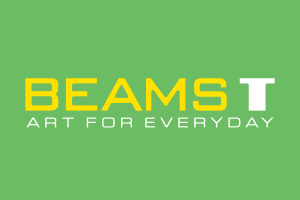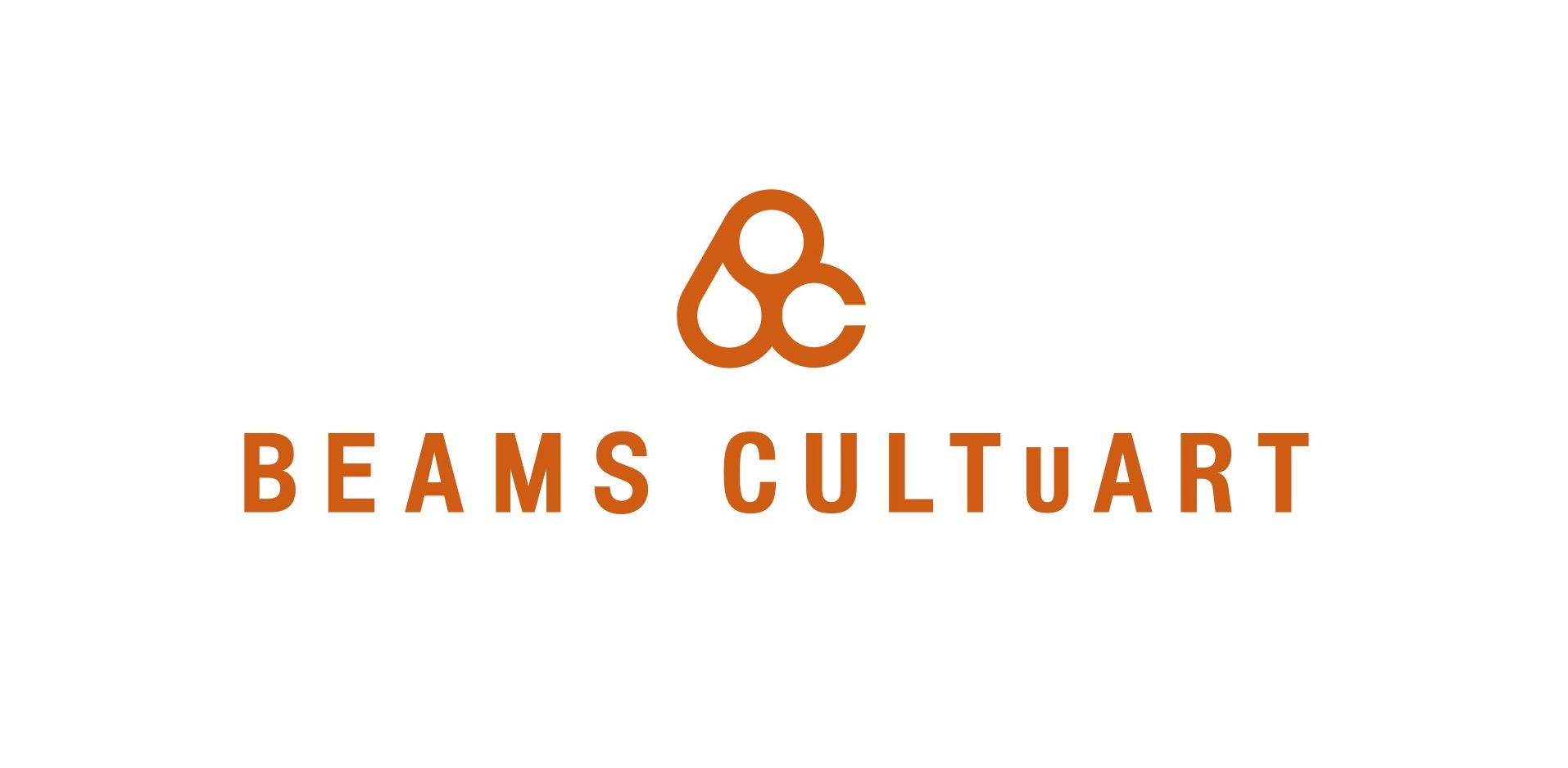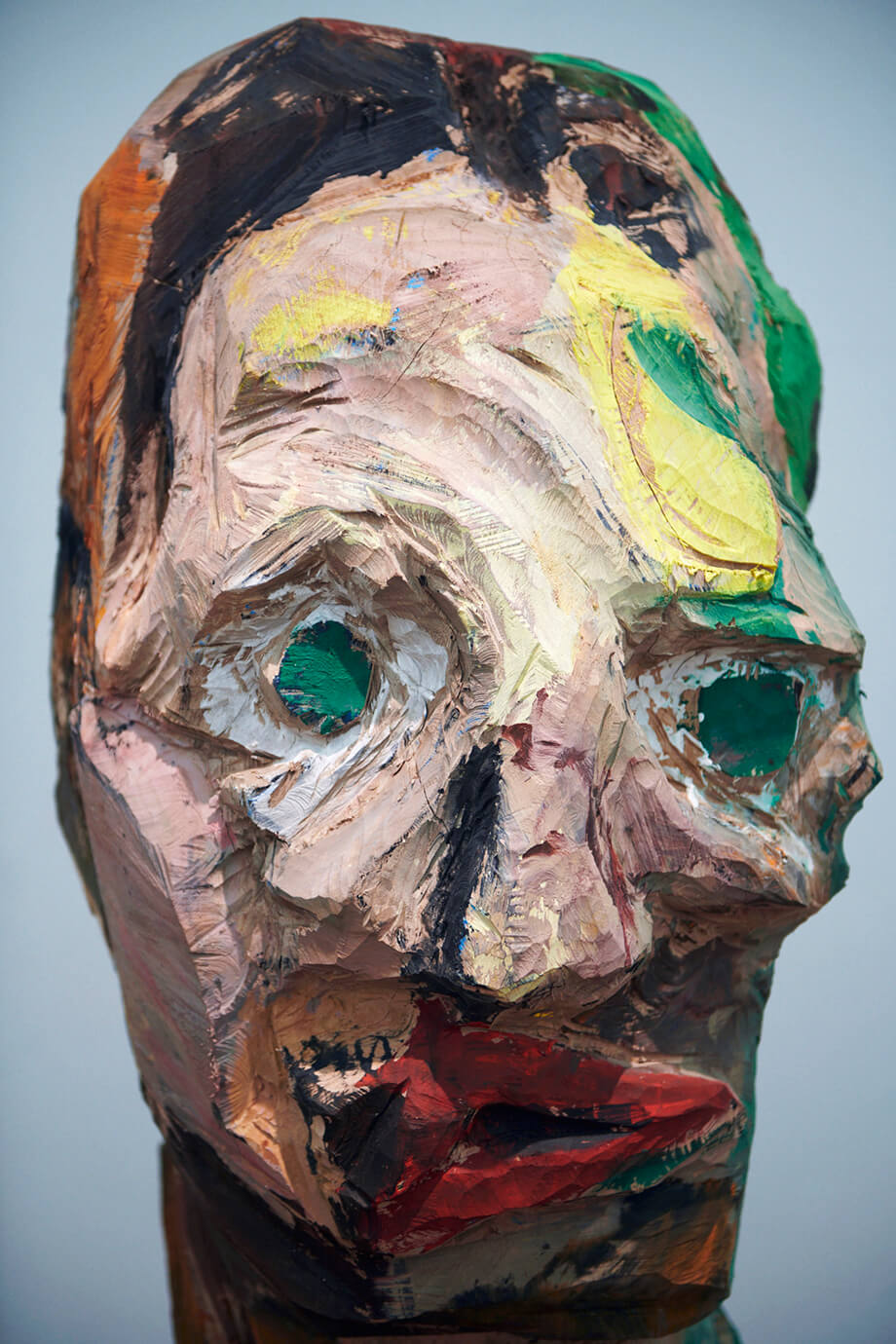

井田幸昌が作品をつくり続ける理由。
The reason why Yukimasa Ida continues to create artworks.
現在、「京都市京セラ美術館」にて、国内外で活動する画家・現代美術家の井田幸昌さんによる初の国内美術館での展覧会『Panta Rhei|パンタ・レイ-世界が存在する限り』が開催されています。この展示に際して、〈ビームス カルチャート(BEAMS CULTUART)〉とコラボレーションアイテム〈YUKIMASA IDA × BEAMS CULTUART〉を3型制作しました。それを記念して、井田さんのアーティストとしての活動のルーツを探ってきました。
Currently, Yukimasa Ida, a prolific painter and contemporary artist known both in Japan and internationally, presents his first domestic museum exhibition titled "PANTA RHEI - For as Long as the World Turns" at the "Kyoto City KYOCERA Museum of Art." Coinciding with this exhibition, three collaboration items, "Yukimasa Ida × BEAMS CULTUART," were created. In commemoration of this, we delve into the origin of Ida's artistic journey.
PROFILE

井田幸昌
(画家、現代美術家)
1990年、鳥取県生まれ。2019年、東京藝術大学大学院油画修了。2016年に現代芸術振興財団主催の「CAF賞」にて審査員特別賞受賞。2017年には、世界的な作家とともにレオナルド・ディカプリオ財団主催のチャリティオークションへ史上最年少で参加。2018年には「Forbes JAPAN」主催「30 UNDER 30 JAPAN」に選出。 2021年には〈ディオール〉とのコラボレーションを発表するなど多角的に活動。制作は絵画のみにとどまらず、彫刻や版画にも取り組み、国内外で発表を続けている。
Instagram:@yukimasaida
ご縁があって制作した〈YUKIMASA IDA × BEAMS CULTUART〉のコラボレーションアイテムは、「ビームス 六本木ヒルズ」「ビームス ニューズ」「ビームス ジャパン 京都」の3店舗で、展示会前に先行発売した。
出会ったものを自分らしく忠実に描きたい。
ー現在、開催されている『Panta Rhei|パンタ・レイ-世界が存在する限り』はキャリアの集大成的な内容になっていますよね。これを踏まえて、まずはどのように作家を目指していったのかについてお伺いしたいのですが、開催地の「京都市京セラ美術館(京都市美術館)」は井田さんが作家を目指すきっかけにもなった場所だそうですね。
井田:そうですね。17歳のときに開催されていた『大エルミタージュ美術館展 いま甦る巨匠たちの400年の記憶』でモーリス・ド・ヴラマンクの作品を観て、感動して1〜2時間そこから動けないぐらいのショックを受けたんです。その独特の荒々しいタッチは自分がやりたいことに近いものでしたし、こんな風に描けたら楽しいだろうなって。すごくスピード感がある絵で、まるで一瞬を切り取ったようだったんです。もう10年以上前のことなんで細かいことは覚えていないんですけど、そういう部分にすごく影響を受けました。
ーその後、どのようにご自身のスタイルを構築していったんでしょうか?
井田:やはりスキルを磨かねばいけない時期というのも自分にもあって、いま思えば面白味のない絵を描いていたと思います。ただの上手な絵とでも言いますか(苦笑)。それでインドを旅したり、いろいろなことを経験する中で、自分がやっていることは一体何なんだろうか、すごくつまらないことをやっているんじゃないか、と考えるようになって。評価もされなかったですしね。それで旅から帰ってきたときに、自分が本当にやりたいことを追究して、自由にやってみたら楽しかったんですよね、絵を描くことが。それが今に繋がるきっかけになっています。


井田:とは言っても、今も自分のスタイルは確立されていないと思いますし、逆に何かに縛られないというのが自分らしいと思っています。水のように臨機応変に形を変えていきながら、今後も表現していきたいと考えていますね。
ーたとえば、展示されているポートレートシリーズなども抽象的な絵だと感じるのですが、写実的な表現と抽象的な表現について、井田さんはどう向き合ってらっしゃるんですか?
井田:写実的、抽象的って言葉が存在していますけど、同時にその言葉が持つイメージに縛られているとも思うんです。すごく簡単な話ですが頭の中に流れてくる色や状態をそのままキャンバスに映し出すことができれば、それは写実的じゃないですか。目の前にあるものを模写しました、それは虚像なのかもしれません。その正確な模写は写実だと言えるのだろうか? そんな逆説が成立してしまう。


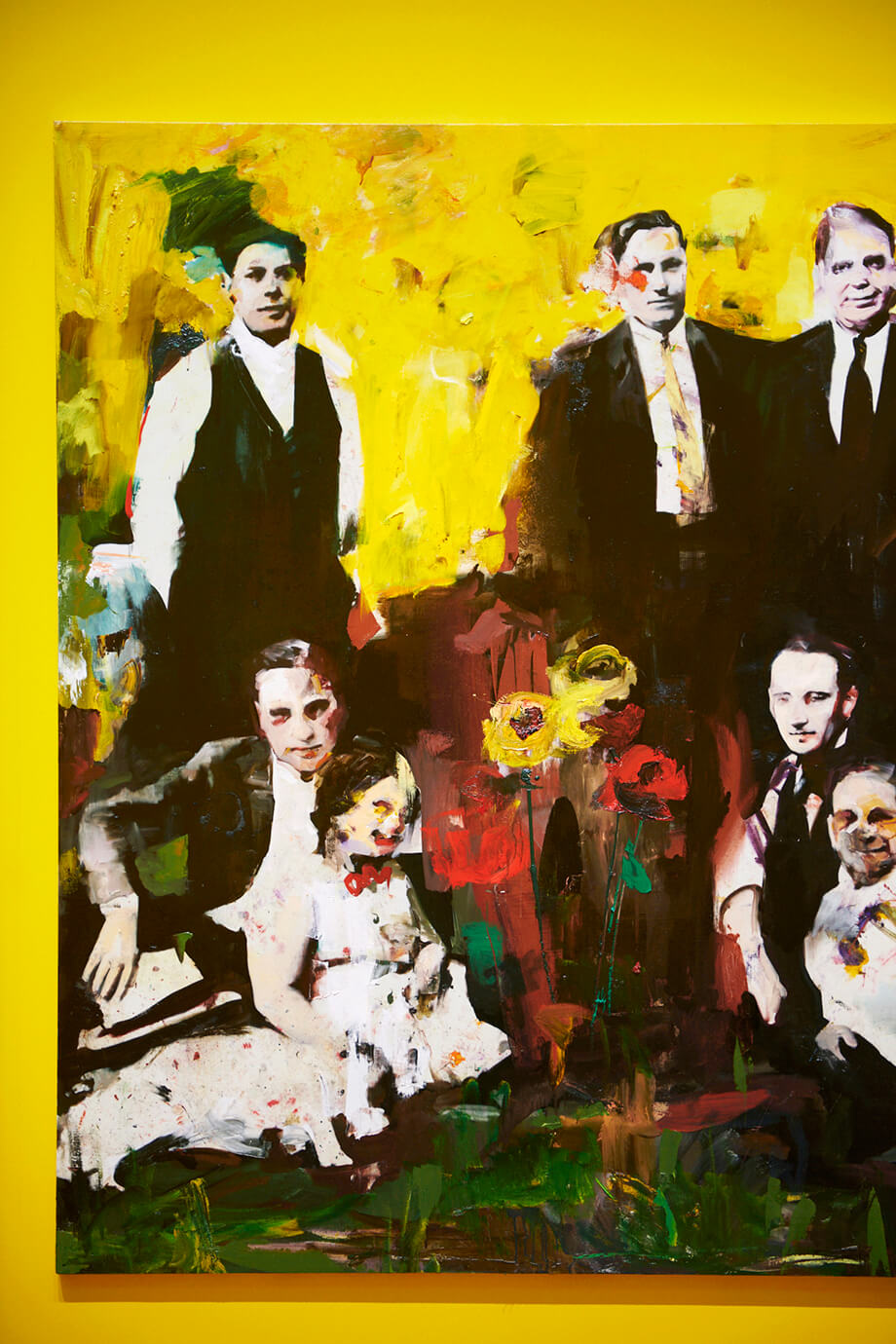

井田:では、ぼくがやりたいことは何かというと、出会ってきたものを自分のフィルターや経験、時間を通して忠実に描くということなんです。特に時間にはすべてが含まれますよね。いろんな情報が含まれた状態の先に出てくるビジュアルが、果たしてリアルである必要性があるのかどうか。そういうことを考えながら絵を描いているので、ぼくは『すべて写実』と言い続けているんです。
作家としてできることはやるべきだと思う。
ー今教えていただいた写実の表現には、井田さんのテーマでもある“一期一会”が重要じゃないかと感じたんですが、このテーマにいたったのは何歳くらいだったんですか?
井田:21、22歳くらいですかね。先ほどお話したインドの旅は初の長期海外旅行だったんですけど、現地でホームレスやガイドの人とかいろんな人に会ったんです。帰国後に旅を振り返ったとき、最初に思い出したのはそんな人たちのことでした。彼らとは、またインドに行ったとしても会えないだろうなと。生死に関わらず会えなかったら、存在を認識できないわけですよね。だから、まずはそれを描き留めようと思ったんです。それで描いているうちに、ふと“一期一会”という言葉が落ちてきたんですよね。そこには時間による刹那性だとか、そういった意味合いもあります。


ー今も井田さんにとって人との出会いはインスピレーションを与えられるものですか?
井田:もちろん。人との出会いは欠かせないですよ。仮に世界にぼく1人しか存在しなかったら、展覧会なんて開催しないわけじゃないですか。人に観てほしいという願望があってやることで、こういうことは人間しかしませんよね。だからこそ出会いは大事だと思います。


ー出会いという意味では、井田さんは非常に広い交友関係をお持ちですよね。SNSに写っている人を見ると驚いてしまうのですが、どのように人間関係をつくっているんですか?
井田:今回の展示でも山田孝之さんや城田優さんが音声ガイドを担当してくれているんですけど、本当に皆さん絵で繋がっている方々なんですよ。交友関係は家族以外、全員絵が起点になっています。絵を描いて発表することで、お会いできてお付き合いしてくださるのですごく嬉しいですね。ちなみに音声ガイドの内容は普通のものと異なっていて、あえてユニークな内容にしているのでぜひ体験していただきたいです。
ー展覧会には彫刻も展示されています。井田さんが大学で専攻されたのは油画ですが、立体をつくるのは彫刻家でもある父親の井田勝己さんからの影響もあるんですか?
井田:幼少期、親父のアトリエが家から歩いて5分程度のところにあって、そこで遊んだりしていたので芸術と触れる機会の多い家庭で育ちました。その後、10代後半で絵の勉強をしていたときに親父から言われたのは、「立体作家は食えないから画家になれ」ってことでした。でも画家もしんどいんですよ(笑)。
でも、ある時期、自分が何をやればいいのかわからないことがあって、そのときに彫刻をやってみたら楽しかったんですよね。幼い頃の原体験というか楽しかった思い出が頭の片隅にあって、それが思い起こされて立体もちゃんとやろうと思ったんです。それに同じことだけずっと続けるのが苦手なタイプでもあるので、何か新しいことにチャレンジしたいと思って立体作品を始めました。
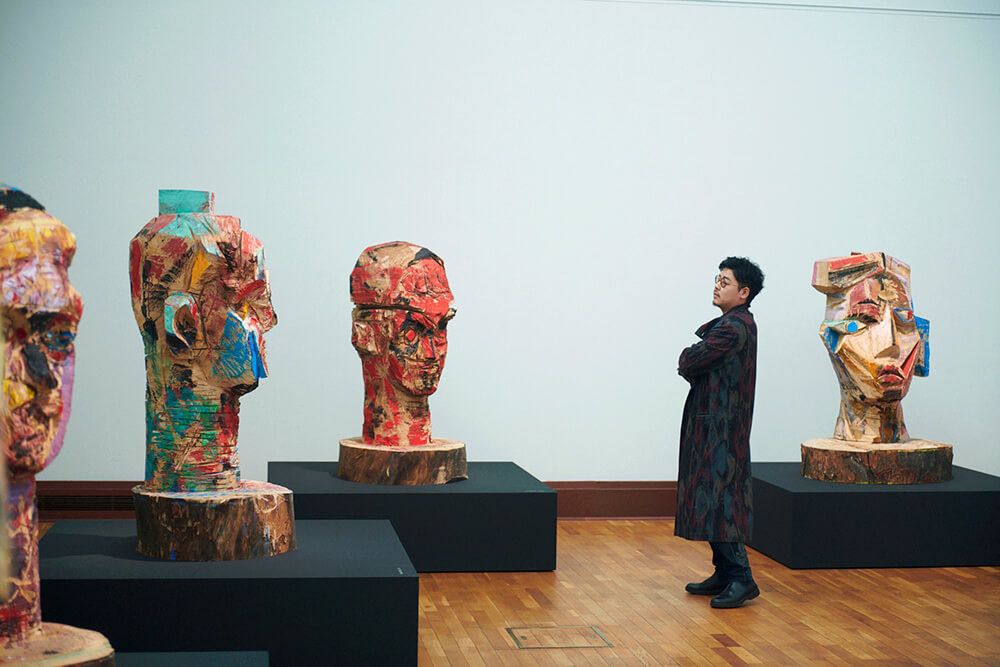
井田:作家がやるべきことって、もちろん自分がやりたいことだと思うんですけど、同時に自分ができることはやるべきだとも思うんですよ。ただできることを淡々とやっていく。そうすると突然自分のやりたかったことに行き着いたりもするわけです。そういうことの積み重ねなのかと思いますけどね。立体作品は自分にとってまさにそういう存在です。
絵は自分よりもずっと偉い存在。
ー2017年には「レオナルド・ディカプリオ基金」のチャリティオークションへ最年少で参加していますよね。ディカプリオさんとのエピソードは非常に有名ですが実際どうでしたか?
井田:それも絵が繋いでくれたことですね。前澤友作さんがネットに上げた絵を見て連絡をくれて、あくる日にはパーティに参加してディカプリオさんからハグされて。さすがに映画の世界みたいだと思いましたけど(笑)。思い起こせば、あのとき何かスイッチが変わった感はありましたね。

井田:ただ、そういう華やかな時間はめったに自分の生活にはなくて、ほとんどはスタジオにこもって1人で一喜一憂しながら作品に集中して、疲れ果てて帰宅して、起きたらまたスタジオへ行くってことの繰り返しですからね。でも、そのスタジオで過ごす時間が自分にとっては宝物だったりするので。そこでできた作品が外に出ていくことによってぼくもくっついていくような感じですね。絵がぼくを引っ張ってくれているというか。この先もずっと絵がぼくよりも偉いところにいて、追いつかないんだろうなと思います。追いつきたくもないですけど。
ー絵の方が偉いとは、どういう意味ですか?
井田:存在としてぼくよりも長生きするし、幸せにする人数が絶対に自分より多いじゃないですか。今、ここにぼくはいますけどこれも幻想ですから。別にぼくがどんな人間だったとしても、生きていようがどうだろうが、絵の立場からすれば関係ないですからね。自分がいなくなっても絵だけは残りますし。
でも、ぼくも生きていかなくちゃいけないし、できるだけ楽しくやりたいからいろんなことにチャレンジしますけどね。やりたいこともありますし。ただ、それを結実させてくれるものは、結局何かをつくるってことなので。そこに集中していけば、先ほどのディカプリオさんのパーティのように夢の一夜みたいな楽しい日が待っていたりするわけです。まぁ、どうしても目立つエピソードが一人歩きしがちですけど、ぼくはこれまで出会った人全員に心から感謝していますよ。そのすべてが地続きに繋がって今がありますから。

INFORMATION
井田幸昌“Panta Rhei|パンタ・レイ-世界が存在する限り”
会期:〜2023年12月3日(日)
場所:京都市京セラ美術館 本館 南回廊2階
PROFILE

Yukimasa Ida
(Painter, Contemporary Artist)
Born in Tottori Prefecture in 1990. Graduated from the Oil Painting Department of Tokyo University of the Arts in 2019. In 2016, received the Special Jury Prize at the “CAF Awards” sponsored by the Contemporary Art Foundation. In 2017, participated in the charity auction hosted by the Leonardo DiCaprio Foundation alongside globally renowned artists, becoming the youngest participant in history. In 2018, selected for “30 UNDER 30 JAPAN” by “Forbes JAPAN.” In 2021, announced collaborations with Dior and engaged in various activities. His artistic repertoire extends beyond painting, encompassing sculpture and printmaking, with exhibitions held domestically and internationally.
Instagram:@yukimasaida
The collaboration items “YUKIMASA IDA × BEAMS CULTUART” were pre-released at three BEAMS stores: “BEAMS Roppongi Hills,” “BEAMS News,” and “BEAMS Japan Kyoto,” prior to the exhibition.
I want to faithfully depict everything I’ve encountered.
– The ongoing exhibition “PANTA RHEI – For as Long as the World Turns” appears to symbolize a culmination of your artistic journey. With this in mind, could you share insights into your early inspirations as an artist? We’ve heard that the venue for this exhibition, the “Kyoto City KYOCERA Museum of Art (Kyoto City Museum of Art),” was also a place that sparked your aspiration to become an artist.
Ida: Yes, that’s right. When I was 17, I saw the works of Maurice de Vlaminck at the exhibition “Our Landscape: 400 years of European Paintings of the State Hermitage Museum.” I was so moved that I couldn’t move from there for about 1-2 hours. His unique, bold strokes were something close to what I wanted to do, and I thought it would be fun to paint like that. His paintings had a tremendous sense of speed, as if capturing a moment in an instant. It’s been over 10 years, so I don’t remember the details, but I was greatly influenced by those aspects.
– How did you navigate the development of your distinctive style after that?
Ida: It was a period when I felt I needed to refine my technical skills, so looking back, I believe I was producing rather mundane artworks. I was just painting well, so to speak (laughs). But, while traveling in India and experiencing various things, I began to wonder what I was doing, whether I was doing something very boring. I wasn’t being recognized either. So, when I returned from the trip, I started pursuing what I really wanted to do and I did it freely, then I found joy in painting. That became the starting point that led me to where I am now.


Ida: That being said, I don’t think my style is fully established even now, and I believe being bound by nothing is what defines me. Like water, I want to adapt and change while expressing myself from now on, too.
– For example, the portrait series exhibited feels abstract to us. How do you approach realistic and abstract expressions?
Ida: While words like realistic and abstract exist, I also feel they’re confined by the imagery they carry. It’s a very simple concept, but if you can project the colors and states flowing through your mind directly onto the canvas, you can call it realistic. Contrarily, when you copy what’s in front of you, that might be an illusion. Can we call that accurate copy realistic? Such paradoxes arise.




Ida: So, what I want to do is faithfully depict everything I’ve encountered through my own filters, experiences, and time. Time especially encompasses everything. Whether such filtered visual images need to be realistic is a question. While pondering over these matters, I keep saying ‘everything is realism’.
As an artist, I believe you should do what you can.
– From what you’ve just told us about the expression of realism, it seems like your theme of “ichi-go ichi-e” is important to you. At what age did you arrive at this theme?
Ida: I think I was around 21 or 22. I mentioned earlier about the trip to India. That was my first long-term overseas trip, and I met various people there, like the homeless, guides, and others. When I looked back on the trip after returning home, the first thing that came to mind was those people. I thought I would never meet them again, even if I went back to India. If you can’t meet someone regardless of life or death, you can’t recognize their existence. So, I wanted to capture them first. While I was painting them, the phrase “ichi-go ichi-e” came to mind. It carries the sense of transience due to time, among other things.


– Is meeting people still something that inspires you?
Ida: Of course. Meeting people is indispensable. If I were the only person in the world, I wouldn’t hold exhibitions, would I? It’s because there’s a desire for others to see it and doing things like this is inherently human. That’s why I think encounters are important.


– In terms of encounters, you seem to have a very broad network of friends. When we see people pictured on your social media, we’re surprised. How do you build your relationships with people?
Ida: In this exhibition, for example, Takayuki Yamada and Yu Shirota are in charge of the audio guide. Everyone involved is really connected through art. All my friendships, except for family, are rooted in art. It’s great to be able to meet and interact with people through painting and presenting my work. By the way, the content of the audio guide is different from usual, deliberately unique, so I would like you to experience it.
– Sculptures are also displayed in the exhibition. Although you majored in oil painting at university, was there also influence from your father, Katsumi Ida, who is a sculptor?
Ida: In my childhood, my father’s studio was about a 5-minute walk from home, so I grew up in a household where I had many opportunities to interact with art. Later, when I was studying painting in my late teens, my father told me, “Sculptors can’t make a living, so become a painter.” But being a painter is tough too (laughs).
However, there was a time when I didn’t know what I should be doing, and when I tried sculpture at that time, I found it enjoyable. I had fond memories from my childhood, and that inspired me to give sculpture a proper try. Also, I’m the type of person who doesn’t like doing the same thing over and over again, so I wanted to try something new and started making sculptures.

Ida: What an artist should do, I believe, is not only what they want to do but also what they are capable of doing. Just do what you can do, steadily. By doing so, you may unexpectedly end up doing what you wanted to do in the first place. I think it’s the accumulation of such things. Sculptures are exactly that for me.
Painting is a much greater presence than myself.
– In 2017, you participated in the charity auction of the “Leonardo DiCaprio Foundation,” being the youngest participant. The encounter with Mr. DiCaprio is very famous, but how was it in reality?
Ida: That was also something facilitated through art. Yusaku Maezawa saw a painting I posted online, contacted me, and the next day, I was at a party where I got hugged by DiCaprio. I couldn’t help but think it felt like something out of a movie (laughs). Looking back, I did feel like something changed at that moment.

Ida: However, those glamorous times are rarely a part of my daily life. Most of the time, I’m holed up in the studio, concentrating on my work while experiencing ups and downs, then I go home exhausted, and the next day, I’m back in the studio again. But the time spent in that studio is precious to me. It feels like I’m also going along as the work I created goes out into the world. It’s like the paintings are pulling me along, you know? I think paintings will always be ahead of me, and I probably won’t catch up. Not that I want to catch up anyway.
– What do you mean by “paintings are ahead of me”?
Ida: Paintings outlive me, and they bring happiness to far more people than I could ever hope to. I’m here now, but this too is an illusion. Regardless of who I am as a person or whether I’m alive or not, from the perspective of the painting, it doesn’t matter. Even if I’m gone, the paintings will remain. But I have to keep on living, and I want to enjoy it as much as possible, so I’ll continue to challenge myself in various ways. There are things I want to do.
However, ultimately, what brings those things to fruition is creating something. If I focus on that, then there will be enjoyable days like the one at DiCaprio’s party waiting for me. Well, it often seems that only the most remarkable episodes are talked about, but I’m sincerely grateful to everyone I’ve ever met. All of those encounters have led to where I am today.

INFORMATION
Yukimasa Ida “PANTA RHEI – For as Long as the World Turns.”
Exhibition Period: Until December 3, 2023 (Sunday)
Location: Kyoto City KYOCERA Museum of Art, Main Building, South Gallery 2nd Floor


